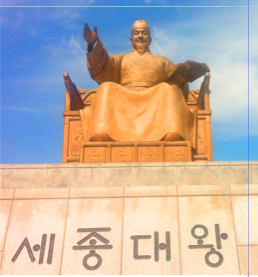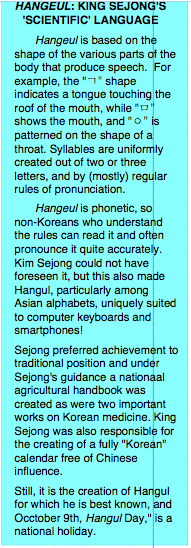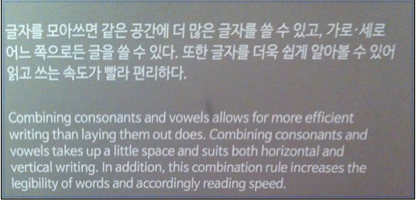Perhaps the most important advancement for Korean literature in the Middle Ages was the development of a Korean alphabet, or Hangul (most often rendered as “Hangul” in English, but technically Romanized as is done here)l. Chinese had historically been the language of the literati, but in order for a real literature, a national literature, to be developed, a national written alphabet was required.
During the Joseon Dynasty (officially 1443, but it actually took a few years) King Sejong decided to create a Korean alphabet, which slowly became the language of literature (very slowly, in fact, as even today some Hanja is still used in South Korean language). KIng Sejong was unhappy with the idea that peasants who were uneducated in Hanja, were therefore essentially illiterate. In an effort to make it easier for ‘normal’ Koreans to read and write, Sejong imagined a set of letters that were Korean, simple to learn, based on the position of the organs of speech when spoken, and formed by two and three letter syllables. At the begining of the Hangul project King Sejong stated his reasons for creating the alphabet:
“Being of foreign origin, Chinese characters are incapable of capturing uniquely Korean meanings. Therefore, many common people have no way to express their thoughts and feelings. Out of my sympathy for their difficulties, I have created a set of 28 letters. The letters are very easy to learn, and it is my fervent hope that they improve the quality of life of all people.” (Korean Overseas Information Service)
King Sejong also had a semi-philosophical goal in mind as the (mainly) three letter syllables were constructed so the initial consonant represented the moving sky, the middle vowel the stationary earth, and the final consonant the human being, both still and in motion.
Hangul originally had 28 letters, but over time that number has declined to 24 in use, and as time goes by, the pronounciation of some of those letters is growing increasingly redundant, used in spelling and not in conversation.
Hangul was originally called “Hunmin chong-um,” meaning “correct sounds for the instruction of the people”. Despite this rather depressingly bureaucratic name, Hangul became the language of Korea. As part of King Sejong’s search for simplicity he decided to create a language that combined consonants and vowels, rather than laying them out, as in English. Combining the two takes up less space and suits horizontal or vertical writing. It can also lead to increased legibility, and thus often to reading speed. For example, here is how the National Hangul Museum renders that idea in both Hangul and English.
In addition, at least in principle, the base consonants of Hangul ㄱ , ㄴ, ㅁ, ㅅ, and ㅇ are formed according to observations of the movements of the speech organs when the consonants are formed. Consequently, the shapes of the basic consonants mirror those of the speech organs.
F|nally, the language is constructed on an ingenious system in which strokes are added to the base forms of vowels and consonants to create new and similar sounding letters that followed consistent patterns. If you learned the stroke patterns for one vowel or consonant, you essentially knew it for all of them.
Hangul’s relative simplicity and small alphabet makes it surpisingly easy to read and the alphabet can be learned in less than a day. Because Hangul is so easy to learn, Korea is a nation with almost no illiteracy and the clustered-letter syllabic nature of Hangul makes the possibility of the creation of new words nearly instantaneous. For instance when chicken & beer restaurants were introduced to Korea, college student merely combined the first syllables of chicken (치킨) and beer (맥주) to create the new word for a chicken and beer restaurant, chi-maek (치맥).
The practical effects of the creation of Hangul were slow at first, but steady and then amazing. Because Hangul could be quickly learned and was natural to the language of Korea, it could be taught to the poor, and particularly to women. In fact, Hangul was sometimes known as the “language of the inner rooms,” (a dismissive term used partly by yangban in an effort to marginalize the alphabet), or the domain of women. Hangul use started simply enough, primarily being used for diaries. Some Confucian scholars and some kings were not proponents of Hangul, considering Hanja to be the proper language of literature, and the usage and propriety of Hangul varied over the centuries. However, Hangul did provide a voice for the poor, disenfranchised, and women.
According to the National Hangul Museum in Seoul, Hangul also revitalized literature as a whole, allowing common people to share in a privilege that had once only only been available to the upper classes – the ability to read and write, including literature. Traditional works, once transmitted only orally, could now be recorded in Hangul by anyone who learned the simple language. This revitalized Korean poetry, particularly gasa and sijo (which remains popular to this day) and eventually helped Korea develop entirely national prose forms such as Koreans based novels and e says.
says.
Thus Hangul came into use to create documents of classical lyrical songs (sijochang), musical storytelling (pansori), mask dance (most famous in Andong, in Korea, which has an annual mask dance festival). Most of Joseon’s most famous plays and performances began to be written in Hangul. An example mentioned it this book, is the famous pansori Chunhyangjeon.
King Sejong fought back against resistance to Hangul by having the Joseon court create projects translating important Confucian and Buddhist works in Hangul, and then distributing them. Practical texts, such as those on military strategy or medicine, were similarly translated. The outcome of these projects, though slow, was thorough, and eventually Hangul became the norm.
After Japan’s defeat in WW2, Hangul finally became entirely free. The demented Japanese colonial plan to make Japanese the official language of Korea was scotched by Japan’s humiliating defeat, and Hangul came into common use and this, among other things, opened the gates for a deluge of female writers, beginning with a trickle in colonial times, and ending up at a current state in which half of the writers and poets in Korea might well be women.





